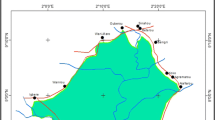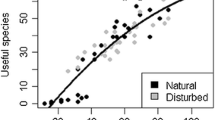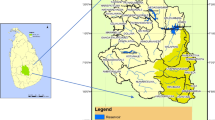Relationship between Use Value and Ecological Importance of Floristic Resources of Seasonally Dry Tropical Forest in the Balsas River Basin, México. The use of seasonally dry tropical forest in the Balsas River Basin, Mexico was utilized as a model to study the relationship between the use value and the ecological importance of wild flora in nine study sites that have an indigenous-Mestizo cultural gradient. Ethnobotanical data from the area were used to obtain the use value per species and correlate it with the ecological importance value of the species found in 0.9 ha. We test the hypothesis that the most used species are the most ecologically important and that this relationship is affected by the changing cultural process that occurs in Mexican rural communities. We registered 320 species, 56.25 % of which are useful and fall into twelve use categories. The study sites showed similar percentages of useful plants. We found relationships between the use value of the species and of the main categories (medicinal, construction, firewood, and food) with the ecological importance value. The frequency was the ecological attribute that determined the use of species in the main categories of use, while the density and dominance attributes were related respectively to the medicinal and food categories. There were differences regarding cultural groups. Indigenous groups mentioned the use of medicinal, edible, and firewood plants more frequently, whereas the Mestizo group pointed out more species used for construction.
Relación entre valor de uso e importancia ecológica de los recursos vegetales del bosque estacional seco en la cuenca del Rio Balsas, Mexico. El uso de la bosque tropical caducifolio de la Cuenca del Río Balsas, México, se utilizó como modelo para estudiar la relación entre el valor de uso y la importancia ecológica de la flora silvestre de nueve sitios de estudio que tienen un gradiente cultural indígena-mestizo. Se consideró información etnobotánica del área para estimar el valor de uso de las especies y se relacionó con el valor de importancia ecológica de las especies encontradas en 0.9 ha. Ponemos a prueba la hipótesis de que las especies más utilizadas son las de mayor importancia ecológica y que esta relación se ve afectada por el proceso de cambio cultural que se presenta en las comunidades rurales mexicanas. Se registraron 320 especies, 56.25 % de ellas son útiles y corresponden a 12 categorías de uso. Los sitios de estudio mostraron el mismo porcentaje de plantas útiles. Encontramos relación entre el valor de uso de las especies y de las principales categorías (medicinal, construcción, leña y alimentos) con el valor de importancia ecológica de las diferentes especies. La frecuencia fue el atributo ecológico que determinó el uso de las especies en las principales categorías, mientras que los atributos de densidad y dominancia se relacionan con las categorías de medicina y alimentos, respectivamente. Hubo diferencias con respecto a los grupos culturales, los grupos indígenas mencionan más especies con usos medicinal, alimenticio y para leña, mientras que el grupo mestizo señaló más especies usadas para construcción. En términos generales, las especies más notables son las más frecuentemente mencionadas como útiles.


Similar content being viewed by others
Literature Cited
Albuquerque, U. P. 2010. Implications of ethnobotanical studies on bioprospecting strategies of new drugs in semi-arid regions. The Open Complementary Medicine Journal 2:21–23.
——— and R. F. P. Lucena. 2005. Can apparency affect the use of plants by local people in tropical forest? Interciencia 30(8):506–511.
———, L. H. C. Andrade, and A. C. O. Silva. 2005. Use of plant resources in a seasonal dry forest (Northeastern Brazil). Acta Botanica Brasilica 19:27–38.
Balée, W. 1998. Historical ecology: Premises and postulates. In: Advances in historical ecology, ed. W. Balée, 13–29. New York: Columbia University Press.
Balvanera, P. and M. Maass. 2010. Los servicios ecosistémicos que proveen las selvas secas. In: Diversidad, amenazas y áreas prioritarias para la conservación de las selvas del Pacífico de México, eds. G. Ceballos, L. Martínez, A. García, E. Espinoza, J. Bezaury Creel, and R. Dirzo, 251–269. CONABIO (National Commission for Knowledge and Use of Biodiversity) / FCE, México.
Benz, B. F., F. Santana, R. Pineda, J. Cevallos, L. Robles, and D. DeNiz. 1994. Characterization of Mestizo plant use in the Sierra de Manantlán, Jalisco-Colima. Mexico. Journal of Ethnobiology 14(1):23–41.
Berlin, B., and E. A. Berlin. 2005. Conocimiento indígena popular: La flora común, herbolaria y salud en los altos de Chiapas. In: Diversidad biológica en Chiapas, eds. N. Ramírez-Marcial and L. Ruiz-Montoya, 371–418. ECOSUR (El Colegio de la Frontera Sur), COCYTECH (Consejo de Ciencia y Tecnología de Chiapas), Plaza y Valdés, S.A. de C.V., México City.
Bye, R. 1995. Ethnobotany of the Mexican dry tropical forests. In: Seasonally dry tropical forests, eds. S. H Bullock, H. A. Mooney, and E. Medina, 423–438. Cambridge, U.K.: Cambridge University Press.
Caballero, J., A. Casas, L. Cortés, and C. Mapes. 2001. Patrones en el conocimiento, uso y manejo de las plantas en pueblos indígenas de México. Estudios Atacameños 16:181–196.
Casas, A., M. C. Vázquez, J. L. Viveros, and J. Caballero. 1996. Plant management among the Nahua and the Mixtec in the Balsas River Basin, Mexico: An ethnobotanical approach to the study of plant domestication. Human Ecology 24:455–478.
Clement, C. R. 1999. 1492 and the loss of Amazonian crop genetic resources. II. Crop biogeography at contact. Economic Botany 53:203–216.
Cunha, L. V. F. and U. P. Albuquerque. 2006. Quantitative ethnobotany in an Atlantic forest fragment of northeastern Brazil: Implications to conservation. Environmental Monitoring and Assessment 114:1–25.
Dirzo, R. and G. Ceballos. 2010. Las selvas secas de México: Un reservorio de biodiversidad y laboratorio viviente. In: Diversidad, amenazas y áreas prioritarias para la conservación de las selvas del Pacífico de México, eds. G. Ceballos, L. Martínez, A. García, E. Espinoza, J. Bezaury Creel, and R. Dirzo, 13–20. CONABIO (National Commission for Knowledge and Use of Biodiversity) / FCE, México.
Fedick, L. S. 1996. New perspectives on ancient Maya agriculture and resource use. In: The managed mosaic: Ancient Maya agriculture and resource use, ed. L. S. Fedick, 1–14. Salt Lake City: University of Utah Press.
Feeny, P. 1976. Plant apparency and chemical defense. In: Biological interactions between plants and insects. Recent advances in phytochemistry 10, eds. J. W. Wallace and R. L. Nansel, 1–40. New York: Plenum Press.
Galeano, G. 2000. Forest use at the Pacific coast of Chocó, Colombia: A quantitative approach. Economic Botany 54:358–376.
Gentry, A. H. 1982. Patterns of neotropical plant species diversity. Evolutionary Biology 15:1–54.
———. 1988. Changes in plant community diversity and floristic composition on environmental and geographical gradients. Annals of the Missouri Botanical Garden 75:1–34.
González-Insuasti, M. S. and J. Caballero. 2007. Managing plant resources: How intensive can it be? Human Ecology 35:303–314.
Hanazaki, N., R. Mazzeo, A. R. Duarte, V. C. Souza, and R. R. Rodrigues. 2010. Ecologic salience and agreement on the identification of tree species from Brazilian Atlantic Forest. Biota Neotropica 10(1):77–84.
Holbrook, N. M., J. L. Whitbeck, and H. A. Mooney. 1995. Drought responses of neotropical deciduous forest trees. In: Seasonally dry tropical forests, eds. S. H. Bullock, H. A. Mooney, and E. Medina, 243–276. Cambridge, U.K: Cambridge University Press.
Kristensen, M. and H. Balslev. 2003. Perceptions, use and availability of woody plants among the Gourounsi in Burkina Faso. Biodiversity and Conservation 12:1715–1739.
Lavin, M. 2006. Floristic and geographical stability of discontinuous seasonally dry tropical forests explain patterns of plant phylogeny and endemism. In: Neotropical savannas and seasonally dry tropical forests. Plant diversity, biogeography, and conservation, eds. R. T. Pennington, G. P. Lewis, and J. A. Ratter, 433–448. The Systematics Association Special Volume Series 69. Boca Raton, Florida: CRC Press, Taylor and Francis Group.
Lawrence, A., O. L. Phillips, A. Reategui, M. Lopez, S. Rose, D. Wood, and A. J. Farfan. 2005. Local values for harvested forest plants in Madre de Dios, Peru: Towards a more contextualized interpretation of quantitative ethnobotanical data. Biodiversity and Conservation 14:45–79.
Lott, E. J. and T. H. Atkinson. 2006. Mexican and Central American seasonally dry tropical forests: Chamela-Cuixmala, Jalisco, as a focal point for comparison. In: Neotropical savannas and seasonally dry tropical forests. Plant diversity, biogeography, and conservation, eds. R. T. Pennington, G. P. Lewis, and J. A. Ratter, 315–342. The Systematics Association Special Volume Series 69. Boca Raton, Florida: CRC Press, Taylor and Francis Group.
Lucena, R. F. P., E. L. Araújo, and U. P. Alburquerque. 2007. Does the local availability of woody Caatinga plants (Northeastern Brazil) explain their use value? Economic Botany 61(4):347–361.
Maldonado, B. 1997. Aprovechamiento de los recursos florísticos en la Sierra de Huautla, Morelos. Tesis de Maestría. Ciudad de México, México: Facultad de Ciencias, Universidad Nacional Autónoma de México.
Martínez-Ballesté, A., C. Martorell, and J. Caballero. 2006. Cultural or ecological sustainability? The effect of cultural change on Sabal palm management among the lowland Maya of Mexico. http://www.ecologyandsociety.org/vol11/iss2/art27/.
Moerman, D. E., R. W. Pemberton., D. Kiefer, and B. Berlin. 1999. A comparative analysis of five medicinal floras. Journal of Ethnobiology 19:49–67.
Monroy-Ortiz, C. and R. Monroy. 2004. Análisis preliminar de la dominancia cultural de las plantas útiles en el estado de Morelos. Boletín de la Sociedad Botánica de México 74:77–95.
Mueller-Dumbois, D. and H. Ellenberg. 1974. Aims and methods of vegetation ecology. New York: John Wiley and Sons.
Murphy, P. G. and A. Lugo. 1986. Ecology of tropical dry forest. Annual Review of Ecology and Systematics 17:67–88.
Peters, M. C. 2000. Precolumbian silviculture and indigenous management of neotropical forests. In: Imperfect balance: Landscape transformations in the pre-Columbian Americas, ed. L. D. Lentz, 203–223. New York: Columbia University Press.
Phillips, O. and A. H. Gentry. 1993a. The useful plants of Tambopata, Peru: I. Statistical hypothesis test with a new quantitative technique. Economic Botany 47:15–32.
——— and ———. 1993b. The useful plants of Tambopata, Peru: II. Additional hypothesis-testing in quantitative ethnobotany. Economic Botany 47(1):33–43.
Pieroni, A. 2001. Evaluation of the cultural significance of wild food botanicals traditionally consumed in northwestern Tuscany, Italy. Journal of Ethnobiology 21:89–104.
Pinheiro, J., D. Bates, S. DebRoy., D. Sarkar, and the R Core Team. 2009. Nlme: Linear and nonlinear mixed effects models. R package version 3.1–91.
Ramos, M. A., P. M. Medeiros, A. L. S. Almeida, A. L. P. Feliciano, and U. P. Albuquerque. 2008. Can wood quality justify local preferences for firewood in an area of Caatinga (dryland) vegetation? Biomass and Bioenergy 32:503–509.
Rhoades, D. F. and R. G. Cates. 1976. Towards a general theory of plant antiherbivore chemistry. In: Biological interactions between plants and insects. Recent advances in phytochemistry 10, eds. J. W. Wallace, and R. L. Nansel, 169–213. New York: Plenum Press.
Rossato, S., H. F. Leitáo-Filho, and A. Begossi. 1999. Ethnobotany of Caicaras of the Atlantic Forest Coast (Brazil). Economic Botany 53:387–395.
Rzedowski, J. 1978. Vegetación de México. México: Editorial Limusa.
Soto, J. C. 2010. Plantas útiles de la cuenca del Río Balsas. In: Diversidad, amenazas y áreas prioritarias para la conservación de las selvas del Pacífico de México, eds. G. Ceballos, L. Martínez, A. García, E. Espinoza, J. Bezaury Creel, and R. Dirzo, 285–320. CONABIO (National Commission for Knowledge and Use of Biodiversity) / FCE, México.
Thomas, E., I. Vandebroek, and P. Van Damme. 2009. Valuation of forest and plant species in indigenous territory and National Park Isiboro-Sécure, Bolivia. Economic Botany 63:229–241.
Toledo, V. M., B. Ortíz-Espejel., L. Cortés, P. Moguer, and M. de J. Ordoñez. 2003. The multiple use of tropical forest by indigenous peoples in Mexico: A case of adaptive management. Conservation Ecology 7(3):9.
Torre-Cuadros, M. D. and G. A. Islebe. 2003. Traditional ecological knowledge and use of vegetation in southeastern Mexico: A case study from Solferino, Quintana Roo. Biodiversity and Conservation 2(12):2455–2476.
Trejo, I. 2005. Análisis de la diversidad de la selva baja caducifolia en México. In: Sobre diversidad biológica: El significado de las Diversidades Alfa, Beta y Gamma, eds. G. Halffter, J. Soberón, P. Koleff and A. Melic, 111–122. SEA (Sociedad Entomológica Aragonesa), CONABIO (National Comission for Knowledge and Use of Biodiversity, CONACYT (Consejo Nacional de Ciencia y Tecnología) y Grupo Diversitas. Zaragoza, España.
——— and R. Dirzo. 2000. Deforestation in seasonally dry tropical forests: A national and local analysis in Mexico. Biological Conservation 94:133–142.
——— and ———. 2002. Floristic diversity of Mexican seasonally dry tropical forests. Biodiversity and Conservation 11:2063–2084.
Turner, N. J. 1988. The importance of a rose: Evaluating the cultural significance of plants in Thompson and Lillooet Interior Salish. American Anthropologist 90:272–290.
Acknowledgments
This article fulfills a partial requirement for the first author for obtaining a Ph.D. degree. The first author thanks the Posgrado en Ciencias Biológicas of the Universidad Nacional Autónoma de México and the Programa de Mejoramiento del Profesorado of the Universidad Autónoma del Estado de Morelos for their support with the scholarship to pursue postgraduate studies. Thanks to Dr. Nestor Mariano, Dr. Andrea Martínez-Ballesté, and Alfredo Saynes for his support in the statistical analysis and manuscript reviewing. Thanks to the editor and two anonymous reviewers for suggestions that greatly improved this article. To our colleagues at CIByC-UAEM for their support in the field-work. To the technicians and specialists at the Herbarium MEXU-UNAM and HUMO-UAEM for their support in the identification of botanical material. To the authorities, inhabitants, and informants in the different localities studied for their collaboration in the field work and for their hospitality.
Author information
Authors and Affiliations
Corresponding author
Electronic supplementary material
Below is the link to the electronic supplementary material.
ESM 1
(PDF 120 kb)
Rights and permissions
About this article
Cite this article
Maldonado, B., Caballero, J., Delgado-Salinas, A. et al. Relationship between Use Value and Ecological Importance of Floristic Resources of Seasonally Dry Tropical Forest in the Balsas River Basin, México. Econ Bot 67, 17–29 (2013). https://doi.org/10.1007/s12231-013-9222-y
Received:
Accepted:
Published:
Issue Date:
DOI: https://doi.org/10.1007/s12231-013-9222-y




